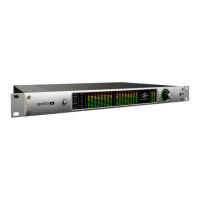Apollo 16 Hardware Manual Rear Panel 14
(4) Power Input
The included 80-watt external power supply plugs into this 4-pin locking XLR jack. Apollo 16 requires 12 volts
DC power and draws approximately 40 watts. During typical operation when a bus-powered Thunderbolt periph-
eral is attached to the Thunderbolt Option Card, the system can draw up to 55 watts.
To eliminate risk of circuit damage, connect only the factory-supplied power supply. Use the Power switch on
the front panel to power the unit on and off.
Important: Do not disconnect the power supply while Apollo 16 is in use, and confirm the Power
switch is in the “off” position before connecting or disconnecting the power supply.
Digital I/O
POWER OUT
ON
OFF
IN
75 OHM TERM
WORD CLOCK
FIREWIRE
UNIVERSAL AUDIO, INC.
PORT 1
( )
PORT 2
( )
MON OUT (R) 2 MON OUT (L) 1
LINE OUT 1-8 LINE IN 1-8
LINE IN 9-16
MADI OUT MADI IN
AES/EBU OUT AES/EBU IN
PUSH
1394 800 (1) 1394 800 (2)
1110
76
9
4
5
8
(5) Word Clock Out
This BNC connector transmits a standard (1x) word clock when Apollo 16 is set to use its internal clock. The
clock rate sent by this port matches the current system sample rate, as specified in the Interface panel of the
Console Settings window within the Console application.
When Apollo 16 is set to use external word clock as its clock, Apollo 16 is a word clock slave. If the incoming
external word clock is within ±0.5% of a supported sample rate (44.1 kHz, 48 kHz, 88.2 kHz, 96 kHz, 176.4 kHz,
192 kHz), Word Clock Out will mirror Word Clock In with a slight phase delay (about 40ns).
(6) Word Clock In
Apollo 16’s internal clock can be synchronized (slaved) to an external master word clock. This is accomplished
by setting Apollo 16’s clock source to Word Clock in the Interface panel of the Console Settings window within
the Console application, connecting the external word clock’s BNC connector to Apollo 16’s word clock input,
and setting the external device to transmit word clock. If Apollo 16 is the last device in the clock chain, the
Termination switch (7) should be engaged.
Note: Apollo 16 can be synchronized to an external “1x” clock signal only. Superclock, overclocking,
and subclocking are not supported.

